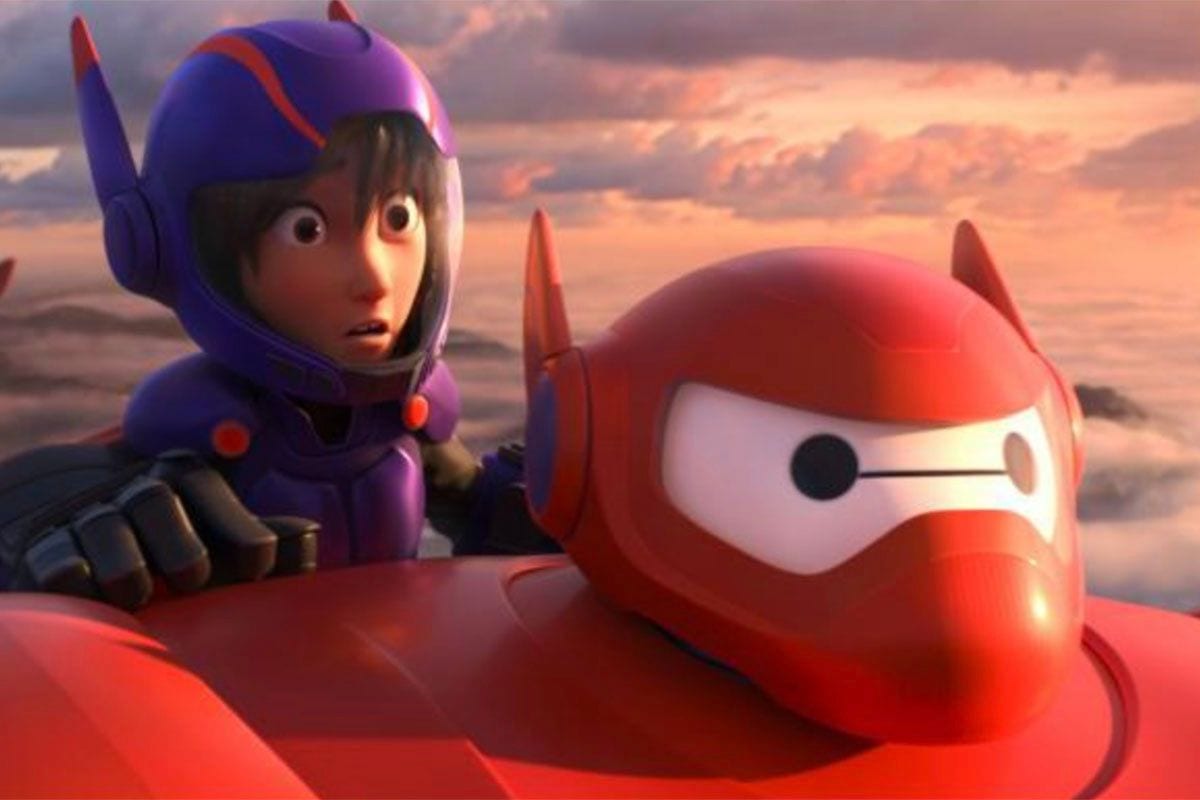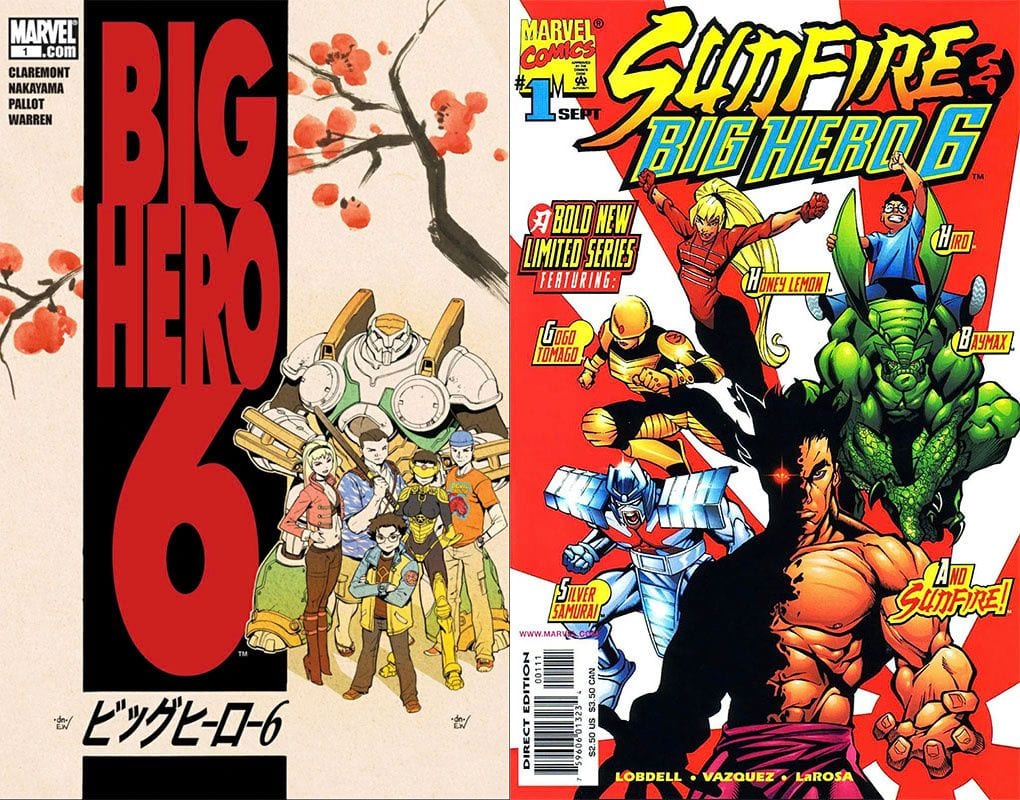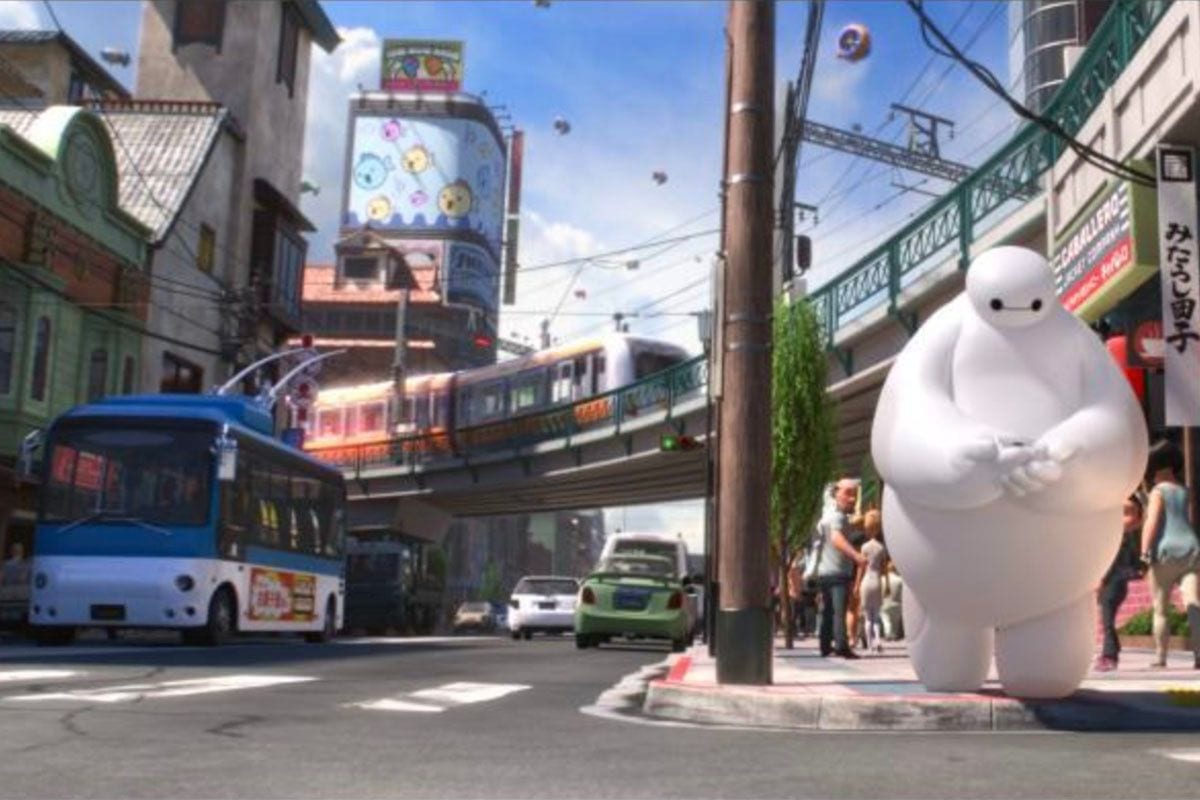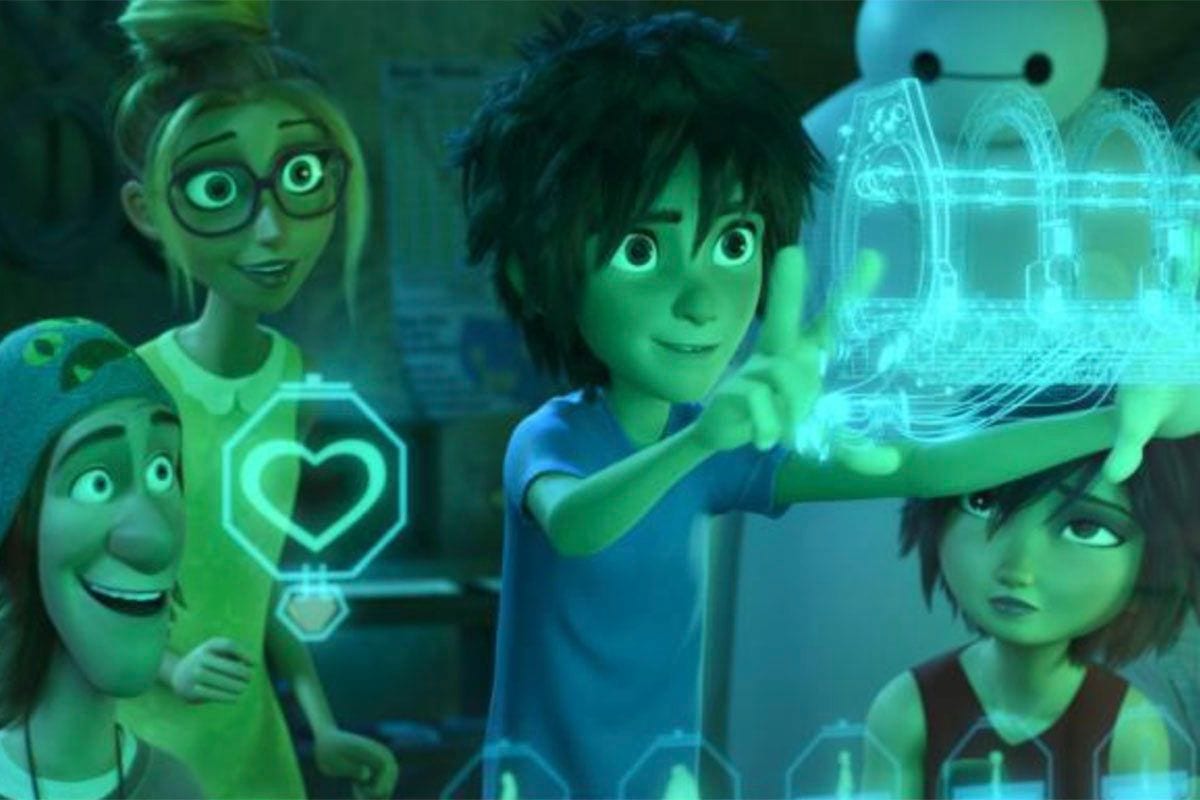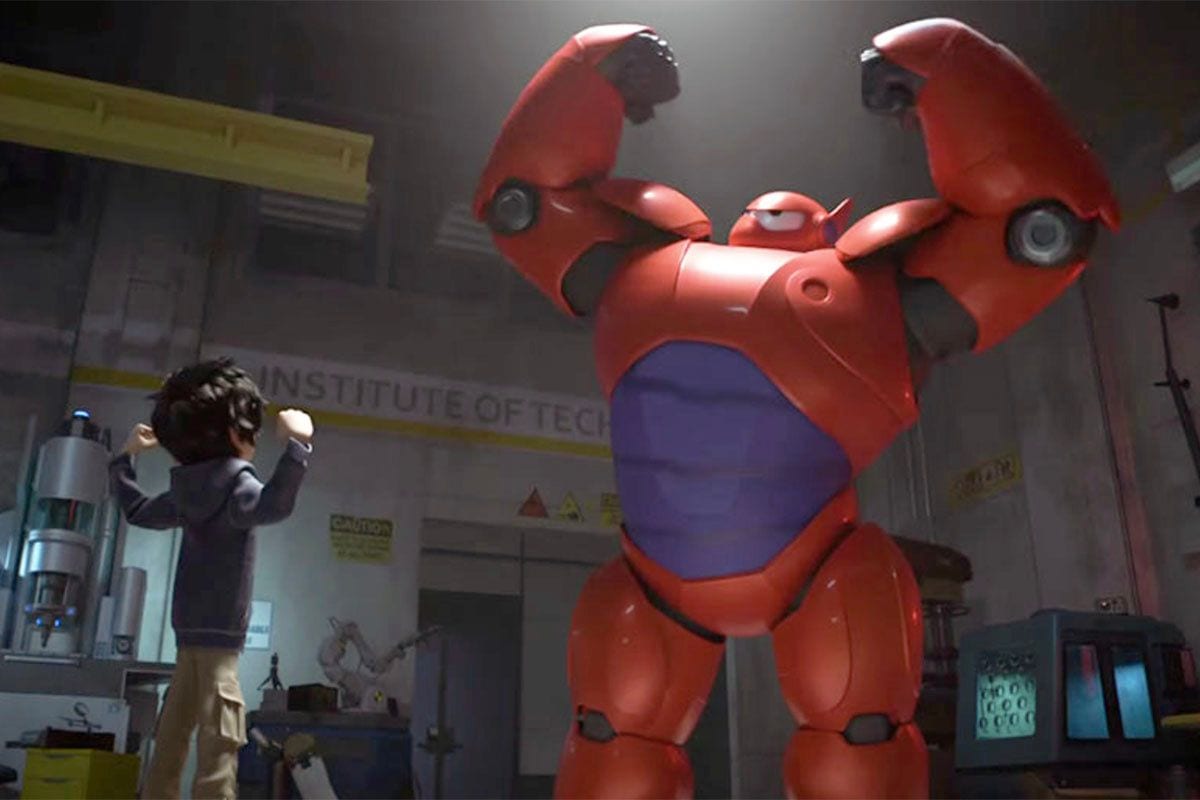(Marvel)
To put Big Hero 6 (Hall & Williams, 2014) in context, we have to go back 25 years. Beginning with The Little Mermaid (Clements & Musker, 1989) and continuing through the ’90s, Walt Disney Animation experienced what is known as the Disney Renaissance. The studio’s animation department had struggled to remain relevant and high-quality in the two decades since Walt Disney’s death. By refocusing on fun, witty, musical, often princess-based films, such as Beauty and the Beast (Trousdale & Wise, 1991), Aladdin (Clements & Musker, 1992) and The Lion King (Allers & Minkoff, 1994), Disney’s signature department returned to its former glory. Around that time, Disney also made a deal with Pixar, a rapidly growing computer animation studio, to distribute Pixar’s films. Toy Story (Lasseter, 1995) revolutionized feature-film animation, and began an unprecedented run of critically-acclaimed and commercially successful films made by Pixar and distributed by Disney.
But whereas Pixar’s success and reputation continued unimpeded throughout the ’00s, Disney’s Renaissance faltered. High-profile failures, such as Treasure Planet (Clements & Musker, 2002) and Brother Bear (Blaise & Walker, 2003), led the company to shut down its legendary hand-drawn animation department in favour of Pixar-esque computer animation. Meanwhile, a seven-film distribution deal between Disney and Pixar ended with the release of Cars (Lasseter, 2006). Pixar entered renegotiations from a position of strength, as theirs were the only profitable and prestigious animated films coming out of Disney at the time. Pixar was purchased outright by Disney, but key Pixar executives, John Lasseter, Ed Catmull and Steve Jobs, ended up with influential new positions within Disney.
Lasseter and Catmull immediately set to righting the Disney Animation ship. The hand-drawn animation department was reopened, and The Princess and the Frog (Clements & Musker, 2009) was commissioned as a hand-drawn, musical princess story in the grand Disney tradition. Walt Disney Animation has experienced another resurgence ever since. They successfully revitalized their musical animated formula, call it “classical Disney animation”, with Tangled (Greno & Howard, 2010), Moana (Clements & Musker, 2016), and especially Frozen (Buck & Lee, 2013). Meanwhile, they have strategically released alternative animated films that break from the musical princess formula, diversifying Walt Disney Animation’s output. In this way, they capitalize on the films that perpetuate their historic brand, while not relying solely on those films. The alternative films are non-musical and typically feature more topical references, humour and attitudes than the classical films. They may not end up being as timeless, but they have been a success for Disney and have kept things fresh. These are Wreck-It Ralph (Moore, 2012), its sequel Ralph Breaks the Internet (Moore & Johnston, 2018), Zootopia (Howard & Moore, 2016) and Big Hero 6.
As Disney’s resurgence was just beginning, they also purchased Marvel Entertainment for $4.24 billion, effective 31 December 2009. There were concerns at the time that Marvel Comics and Marvel Studios would become “disneyfied” as a result of Disney’s historically sanitized, family-friendly corporate image, but that has not really seemed to happen. Disney purchased Marvel because it was a successful company, and they have outwardly let it continue to run as it did before (that is, successfully). There was also speculation about synergy of traditionally Disney characters appearing in Marvel properties or vice versa, but there has not been much cross-pollination either.
Fransokyo (Amazon)
Big Hero 6 is the clearest example of corporate synergy to-date, a Walt Disney Animation Studios film based on a Marvel Comic. But even so, the comic on which the film is based is so obscure, and the adaptation changes so much about the comic, that it barely even counts as a Disney-Marvel joint venture. This is a Disney animated film, first and foremost. It just happens to be lightly inspired by a Marvel Comic.
Big Hero 6 is a Japanese superteam created by Steven T. Seagle and Duncan Rouleau for Alpha Flight #17 (December 1998). Prior to that appearance, however, they were introduced in the three-issue miniseries Sunfire & Big Hero 6 (September-November 1998). The team is assembled by the Japanese government and put under the leadership of the Silver Samurai, historically a Marvel villain. The Silver Samurai recruits characters such as Honey Lemon and GoGo Tomago, but is initially turned down by Hiro Takachiho. Hiro is a brilliant young inventor who creates Baymax, a synthetic bodyguard that can turn into a dragon and has the brain patterns of Hiro’s deceased father.
Hiro ultimately joins the team, as does Sunfire, a Japanese mutant created for Uncanny X-Men in the ’60s. Eventually the Silver Samurai and Sunfire leave the team, Hiro becomes the leader, and several new members are added. After the initial appearances in 1998, Big Hero 6 appeared in a five-issue miniseries from 2008-2009, and that is about it. The property had very few issues, no real impact and relatively few fans.
While researching Marvel properties to adapt, Disney producer Don Hall chose Big Hero 6 mainly because he liked the name. The film keeps superficial elements of the comics, but mostly reinvents the property. The idea of a superteam, and characters named Honey Lemon and GoGo is retained. Hiro’s last name is changed, but he remains a brilliant young inventor. The film’s Baymax is cuddly, and is not created by Hiro, but he still represents a link to Hiro’s deceased relative (brother, rather than father). The setting is somewhat Americanized, with the creation of San Fransokyo, a fictional, retro-futuristic version of San Francisco remodelled with heavy Japanese influences. The obscurity of the Big Hero 6 property allowed Walt Disney Animation to dip their toes into Marvel Comics while still having the creative freedom to alter the property to fit their needs.
Ultimately, Big Hero 6 is a Disney film above all else, with some Pixar and Marvel flavour added to the formula. Many Disney animated films centre on characters that, despite or because of their talents, begin the films as outcasts. Over the course of the film, the central character(s) find a sense of belonging only after embracing their identity and finding their self-worth. This description could apply to both bookish Belle and secretly-sweet Beast in Beauty and the Beast, the diamond in the rough Aladdin in Aladdin, absentee heir to the throne Simba in The Lion King, shut-in with a heart of gold Quasimodo in The Hunchback of Notre Dame (Trousdale & Wise, 1996), ancient Greek superhero Hercules in Hercules (Clements and Musker, 1997), feminist warrior Mulan in Mulan (Bancroft & Cook, 1998), poor workaholic Tiana and rich hedonist Naveen in The Princess and the Frog, agoraphobic Rapunzel in Tangled, and vilified Ralph in Wreck-It Ralph, not to mention Elsa in Frozen, whose parents terrified her about ever using her ice powers. All of these characters begin as outcasts in some way with low self-worth, and end up finding where they belong after embracing their differences.
(Amazon)
This is also true of Hiro Hamada, the main character of Big Hero 6, making the film thematically Disney. However, the central relationship in Disney animated films is typically (but not exclusively) romantic, whereas Pixar films tend to skew more towards stories about friendships. The central relationship of Big Hero 6 is the friendship between Hiro and Baymax, a medical care robot created by Hiro’s brother, demonstrating some Pixar influence on the film.
With the primary theme and relationship defined by Disney and Pixar, the Marvel superhero genre is merely the medium through with the story is told. There is an origin story, a dangerous supervillain, and equipment-building scenes that seem directly inspired by Iron Man (Favreau, 2008), but this is simply window dressing. Marvel films at this time were beginning to explore the superhero genre through the lens of other genres, such as superhero film through the lens of ’70s paranoid thriller in Captain America: The Winter Soldier (Russo Brothers, 2014). Big Hero 6 subverts that trend. This is a Walt Disney Animated film through the lens of a superhero film. When analyzed as a Disney film, the result is unique and interesting. As a Marvel film, the result is fairly unremarkable. So, one’s enjoyment of the film comes down to how one approaches it.
Big Hero 6 opens with no Marvel logo, another clue that it’s not primarily a Marvel film, followed by a beautiful showcase of San Fransokyo. The city is incredibly detailed, and its rendering is the crowning technical achievement of the film. The buildings and streets are impeccably-designed to look nearly photorealistic, which is somehow not undermined when populated by distinctly cartoonish people. Indeed, the film seems to revel in any chance to show off the city. Fourteen-year-old Hiro (Ryan Potter) is introduced hustling at an illegal underground robot fighting match. His little robot made of magnetically-attached spheres and cones seems flimsy and easily-beaten at first, but it turns out to be endlessly maneuverable and nearly indestructible.
Hiro is saved from his unhappy opponents by his brother, Tadashi (Daniel Henney), and they are both bailed out of jail by their Aunt Cass (Maya Rudolph) after the match is raided. Hiro and Tadashi have lived with Cass since their parents died (dead parents is perhaps the most common Disney animation trope), and they are both brilliant engineers. Tadashi worries that Hiro’s talents have been wasted ever since his early high school graduation and, in an effort to inspire him, brings Hiro on a tour of his lab at the San Fransokyo Institute of Technology.
At the school, Hiro meets other students, Go Go (Jamie Chung), Wasabi (Damon Wayans Jr.) and Honey Lemon (Genesis Rodriguez), Fred (T.J. Miller), the school mascot, and their mentor, Robert Callaghan (James Cromwell). Hiro is amazed by their projects, particularly Tadashi’s medical care robot, Baymax (Scott Adsit). At the sound of medical distress, Baymax inflates his white vinyl body out of his red charging box to offer his assistance. He toddles around, moving very gently and deliberately, speaks in a very funny stilted A.I. voice, and is just adorable. The filmmakers wanted to depict a unique type of cinematic robot, and were inspired by the Soft Robotics and Bionics lab at Carnegie Mellon University. After the tour, and encouraged by Tadashi, Hiro makes attending the school his new goal. He enters a science fair at the school, hoping that an impressive presentation will earn him admission.
(Amazon)
Hiro miniaturizes the concept behind his versatile, maneuverable robot from the beginning of the film. He creates tens of thousands of “microbots”, each consisting of a sphere and two magnetically-attached cones. Using a neuropathic headband, Hiro is able to mentally control all of the microbots at once to form any structures or perform any tasks that he can imagine. His presentation, where the microbots click-clack at his command into any shape, build or carry objects, and even transport Hiro around the presentation hall, is an overwhelming success, and Callaghan immediately offers him admission to the school. Hiro also gets the attention of Alistair Krei (Alan Tudyk), a sleazy businessman who offers to buy the microbots outright. Following Callaghan’s lead, Hiro rebuffs the offer and leaves to celebrate.
These early scenes are very economical, establishing many characters, relationships and other elements that will be used throughout the film without ever feeling like information overload or heavy-handed foreshadowing. The most important concepts are Hiro’s clear engineering brilliance and the inspirational impact of his brother, Tadashi. Tadashi pushes Hiro to use his talents to the fullest, and chooses to use his own talents to create a medical robot capable of helping countless people around the world. Unfortunately, that altruistic instinct also drives Tadashi to rush into the presentation hall when it catches fire to save Callaghan, declaring “someone has to help.” Tadashi and Callaghan are killed, and Hiro’s microbots are destroyed. This, of course, doubles down on Disney’s dead relative trope. With his main inspiration and cheerleader killed in front of him, Hiro withdraws into himself. He refuses to eat, talk to Aunt Cass, or attend school.
One day, Hiro stubs his toe in his room, and his cry of pain activates Baymax in Tadashi’s room. Hiro dismisses Baymax, pushing him away like everyone else. When Hiro finds one leftover microbot in his room and the microbot seems drawn in a particular direction, an off-handed comment from Hiro directs Baymax to follow it into the city. Hiro gives chase, and the microbot leads them to an abandoned warehouse where millions of microbots are being manufactured. They are spotted by a dark figure in a mask, who controls the microbots. The menacing use of the microbots is very striking, as they carry the villain along and attack in an impossibly-fast, deliberate geometric wave. Hiro and Baymax barely escape, and return home. Once there, Hiro deduces that the science fair fire must have been set by the person who stole his microbots, making that person responsible for Tadashi’s death. At the same time, Baymax identifies that Hiro’s main medical issue is grief, and he resolves to give Hiro treatment accordingly.
This scene is absolutely perfect, a triumph of efficient screenwriting. It establishes the missions of the central characters: Hiro seeks justice for his brother’s death, and Baymax seeks to treat Hiro’s grief. The scene also unites their motivations, as Baymax determines that finding Tadashi’s killer will help ease Hiro’s grief. So, the characters are united in common purpose, but for very different reasons. This will keep them working together until, inevitably, their differing motives will cause conflict. The relationship between Hiro and Baymax is also well-conceived, as Baymax offers Hiro an indirect link to his brother. It doesn’t hurt that Baymax is also such a crowd-pleaser of a character, cute, cuddly, compassionate and so funny. Also, Hiro upgrades Baymax for their next confrontation with the masked villain, which breaks him out of his funk and puts him back in the lab. It’s a great scene, well-executed, and it lays the groundwork for the remainder of the film.
Upgrading Baymax is the first scene that feels directly inspired by
Iron Man. Hiro builds an armour to protect Baymax’s soft body, and he even uses three-dimensional holographic interfaces to design, just like Tony Stark in Iron Man. Hiro also programs a second control chip, to work alongside Tadashi’s medical program chip, that teaches Baymax to fight and be generally more aggressive. They track the microbots to the docks, where they are met by Go Go, Wasabi, Honey Lemon and Fred. Baymax contacted them, as his research into grief indicated that contact with friends can help. They are all spotted by the masked man, who attacks with the wave of microbots. What follows is a surprisingly excellent car chase through downtown San Fransokyo at night. With the team now assembled, they retreat to Fred’s home (an enormous mansion).
Fred points out the superhero tropes at play in a bit of winking postmodern commentary that the film does not really need. He calls out Hiro’s “origin story”, dubs the masked attacker a “supervillain”, and deduces his identity to be Alistair Krei, the shady businessman who wanted Hiro’s microbots. The group agrees to help Hiro stop Tadashi’s killer, and Hiro offers to remodel their school projects into super-suits. He does so in a montage set to Fall Out Boy’s “Immortals”, a painfully bad song written for the film.
Go Go’s frictionless magnetic bicycle wheels are turned into discs she can use to skate on or throw at opponents. Wasabi’s laser plasma is added to gloves, allowing him to cut through anything. Honey Lemon’s multi-faceted chemicals are put into balls that she can throw to disable opponents. Even Fred’s school mascot costume is turned into a functional, fire-breathing dragon suit. Lastly, Baymax’s medical sensor and armour are upgraded, giving him rocket fists and the ability to fly.
Hiro creates a suit that allows him to ride on Baymax, which he does in another beautiful showcase for the San Fransokyo design. These are fun scenes, if nothing new. It’s enjoyable to see the team outfitted. Also, a main character soaring through the air on the back of another character has been in countless films, from The Neverending Story (Peterson, 1984) to Avatar (Cameron, 2009), and could even be seen as another Iron Man reference. Regardless, the sequence is beautiful and exhilarating in this film.
James Cromwell voices Robert Callaghan (Amazon)
Go Go’s frictionless magnetic bicycle wheels are turned into discs she can use to skate on or throw at opponents. Wasabi’s laser plasma is added to gloves, allowing him to cut through anything. Honey Lemon’s multi-faceted chemicals are put into balls that she can throw to disable opponents. Even Fred’s school mascot costume is turned into a functional, fire-breathing dragon suit. Lastly, Baymax’s medical sensor and armour are upgraded, giving him rocket fists and the ability to fly.
Hiro creates a suit that allows him to ride on Baymax, which he does in another beautiful showcase for the San Fransokyo design. These are fun scenes, if nothing new. It’s enjoyable to see the team outfitted. Also, a main character soaring through the air on the back of another character has been in countless films, from The Neverending Story (Peterson, 1984) to Avatar (Cameron, 2009), and could even be seen as another Iron Man reference. Regardless, the sequence is beautiful and exhilarating in this film.
The flight allows Baymax’s enhanced sensor to scan the entire city to pinpoint the masked man. This leads the team to a Krei facility on a nearby quarantined island. Old security footage shows that the island was the site of a failed experiment in teleportation portals. When a test pilot, Abigail (Katie Lowes), went through the portal, it malfunctioned, exploded, and Abigail was lost. As they watch the old footage, the masked man appears and Hiro’s team attacks. They constantly get in each other’s way, a classic trope of early superhero team battles, but then things turn serious. The villain is unmasked and revealed to be Callaghan, not Krei. Callaghan set the fire to cover his theft of the microbots, and Tadashi was collateral damage. Enraged, Hiro removes Baymax’s medical chip and orders him to kill Callaghan. Horrified, Hiro’s team fights Baymax until they can restore his medical chip, allowing Callaghan to escape.
I like how the film confronts the motivations behind Hiro’s drive for justice. So many superheroes are driven by the death of a loved one. Typically, this turns them into altruistic protectors, wanting to prevent innocent people from being killed while refusing to become killers themselves. In Hiro’s case, his motivations are not altruistic. He wants to kill the man responsible for his brother’s death. It’s bold and brings him into conflict with Baymax. Baymax agreed to help Hiro to find Tadashi’s killer as a way to treat grief, but a medical robot is not programmed for revenge killing. Callaghan’s reveal was also a nice twist. The film had been relatively straightforward up to that point, so Krei seemed like a logical villain and a great red herring.
Beyond being a surprise, the further revelations about Callaghan’s motivation also offer another opportunity to explore grief and revenge. Abigail, the lost test pilot, was Callaghan’s daughter. He blames Krei for her death, and stole the microbots to rebuild the teleportation device and attack Krei. Hiro and Callaghan are both brilliant engineers who desire to kill the man responsible for their family member’s death. The best heroes and villains are doppelgangers, twisted reflections of each other.
Thankfully, Hiro is pulled back from villainy, from being consumed by revenge, by Baymax. He shows Hiro archived videos of Tadashi’s many mistakes and failures as he created Baymax. This reminds Hiro of his brother’s irrepressible desire to help people, and pulls him back from the brink. He apologizes to the team, and they rush out to stop Callaghan from destroying Krei’s new building and killing Krei. The microbots assemble a teleportation portal above the building, and it begins to suck in everything. Giant portals in the sky were also seen in recent Marvel films The Avengers (Whedon, 2012) and Thor: The Dark World (Taylor, 2013). Hiro leads his team to work together to fight the microbots and send most of them into the portal. With the microbots depleted, Callaghan is powerless and easily defeated.
However, before they destroy the portal Baymax senses a living human inside. Hiro realizes that Abigail survived, and he rides Baymax into the portal to save her. They fly through psychedelic visuals and the wreckage of Krei’s building to reach her pod, but Baymax is damaged on the way out. He insists on firing his rocket fist to save Hiro and Abigail, leaving him stuck behind. Hiro tearfully agrees, but has the opportunity to say goodbye to Baymax properly, unlike Tadashi.
In the aftermath, Abigail is revived and Callaghan is arrested. Hiro finally goes to school, taking over Tadashi’s old lab. He displays the rocket fist, and notices Baymax put his programming chip inside. When Hiro rebuilds Baymax, the chip restores him completely. Hiro and his friends also decide to continue as a superteam. Though never said in the film, the title card dubs them Big Hero 6. The credits roll and depict images and newspaper headlines of the team protecting the city as superheroes.
In the grand Disney tradition, Hiro begins as an outcast. He is a brilliant engineer, a high school graduate at age fourteen, with no direction in life and is wasting his time bot-fighting. His newfound direction is almost derailed by his brother’s murder. First he withdraws from everyone, then he sets out on a mission of revenge. But ultimately, inspired by his brother’s brilliance and altruism, Hiro embraces his identity and uses his skills for good. In doing so, he finds a sense of belonging amongst Tadashi’s friends. These are classic Disney themes. Alongside these themes, however, there are classic superhero tropes. Hiro is motivated by the death of a loved one, he uses his special skills to become a superhero, and he battles a supervillain that is a dark reflection of himself.
By exploring Disney themes through a superhero lens, the filmmakers created a striking, original Disney animated film. As a superhero film, however, it’s very conventional. I honestly hesitated to even cover it for this series on Marvel films, because it bears so little resemblance to the comic on which it is based, and it really is more of a Disney animated film than a Marvel film. The superhero aspects seem like a series of checked boxes in the genre. Also, I find that Big Hero 6 lacks the emotional punch that I expect from a great Disney film. The classical Disney films achieve this with ease, and I even find the alternative films like Wreck-It Ralph to be surprisingly affecting.
So what does Big Hero 6 have going for it? The film is absolutely gorgeous and brilliantly animated, as one might expect from Walt Disney Animation Studios. Also, the story is exceedingly well-told, despite being mostly unsurprising and emotionally underwhelming. I can imagine this being a great gateway film to familiarize kids with the superhero genre when they are still a bit young for the PG-13 live-action films.
Also, the film was very successful. Big Hero 6 premiered at the Tokyo Film Festival in October 2014 before its release in November. It was the highest-grossing animated film of 2014, and went on to win Best Animated Feature at the Academy Awards. This was the second win in a row for Walt Disney Animation Studios, after Frozen won the previous year. There was talk of a potential sequel, but that seems doubtful since the launch of Big Hero 6: The Series in 2017. I think the film will be seen as an interesting curiosity in the future. A rare bit of early synergy between Disney and Marvel, and an atypical Disney Animation foray into a different genre, the superhero film. But underneath this interesting trivia is a beautiful, entertaining film that is certainly worth revisiting.
***
Stan Lee Cameo Corner/Credit Scene(s): Director Don Hall realized very close to release that audiences may expect a post-credits scene, a practice that had become well-established by this point in superhero films and blockbusters. Not wanting to disappoint anyone, he quickly put together a scene. Fred speaks to a painting of his absent father, who looks like Stan Lee, and discovers a secret room behind the painting. He finds superhero costumes and gadgets, implying that Fred’s father is a superhero. Fred’s father, voiced by Lee, appears and embraces his son. That is 22 Stan Lee cameos in 35 films.
First Appearances: T.J. Miller, the voice of Fred, co-stars in the Deadpool films.
Next Time: The Avengers return with a mild sophomore slump.

